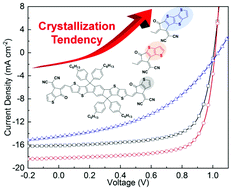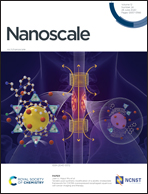Fine regulation of crystallisation tendency to optimize the BHJ nanostructure and performance of polymer solar cells†
Abstract
Optimizing the nanostructure of the active layer of polymer solar cells (PSCs) is one of the main challenges to achieve high device performances. The phase separation of the donor polymer and molecular acceptor within the bulk heterojunction (BHJ) layer is often driven by the crystallisation of the acceptor molecules. Hence, a suitable crystallisation tendency of the chosen acceptor is ultimately important. In this work, we identified melting temperature as an indicator for the crystallisation tendency and introduced extended fused-aromatic rings to the end groups of the nonfullerene acceptor molecule to enhance the intermolecular binding energy as well as its crystallisation tendency. The crystallinity, crystal regularity and average crystal size were significantly increased for those molecules with larger fused end groups. The devices containing molecule IDTTC with two fused thiophene rings, which displayed intermediate crystallisation tendency, were found to possess an optimized phase separation scale, balanced hole/electron mobility and highest device performances with the fill factor as high as 73.2% and a power conversion efficiency of 13.49%. With the above observations, we established a new route and paradigm to adjust the crystallisation tendency and BHJ nanostructure of nonfullerene acceptor molecules, thus enhancing the device performances through molecular engineering.



 Please wait while we load your content...
Please wait while we load your content...